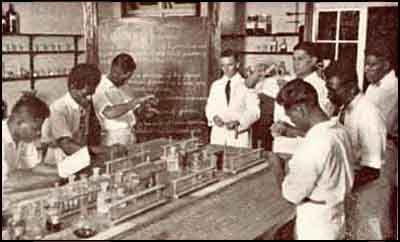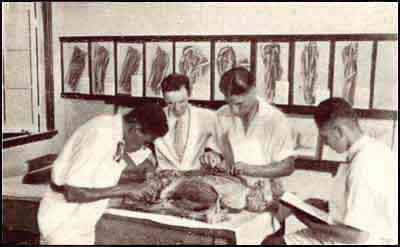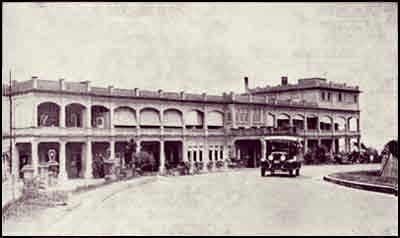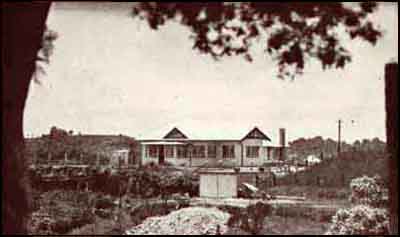Fiji's Central Medical School 1884 - 1941,
and The Colonial War Memorial Hospital 1923 - 1941
Excerpt from Handbook of Fiji, G.K.Roth (editor), 1937 (p.48):
In 1884 a native medical school was started at the Colonial Hospital, Suva, where a three years course of training was given to suitable Fijian youths selected after competitive examination. ...
This was the humble start of what would finally, in 1998, become the Fiji School of Medicine, granting MBBS degrees to its graduates.
|
|
Lecturers and students at the Native Medical School, 1888.
The first three Fijians to graduate after completing their 3-year course of training did so in 1888, and were licensed as Native Medical Practitioners [NMP]. This photograph may have been taken on the occasion of their graduation, but it is unclear which if any of the men in the photograph were the new graduates.
In the years that followed, as well as more Fijians, the first Rotuman graduated in 1912, two from Tokelau in 1916, the first Indian in 1926 (licensed as an Indian Medical Practitioner (IMP), and the first Samoan in 1927.
|
Excerpt from the The Colony of Fiji 1874-1929, A.A.Wright (editor), 1929 (p.48):
With the assistance of £319,500 subscribed by the public for a War Memorial, the Colonial War Memorial Hospital was built, and completed at the end of 1923. This is controlled by the Government and there are two resident medical officers. The main buildings are ferro-concrete, and contain an out-patient department, administratior offices, ward accommodation for twenty-eight Europeans and eighty natives, kitchen, laundry, operating-room, X-Ray-room, clinical laboratory, nurses home, and lecture-room. The hospital is fitted throughout with hot and cold water, electric light, telephones and a water carriage sewage system. There is a staff of seventeen European and ten native nurses.
The Native Medical School is attached to the hospital; there were twelve Fijian, three East Indian, five Samoan, and four Gilbert Island students in training in 1928.
The new Medical School has recently been completed with accommodation for forty students. In addition to receiving Fijian and East Indian students from Fiji the school provides instruction for students from Samoa, Tonga, the Cook Islands, and the Solomon Islands. The Administrations contribute towards the capital expenditure and annual cost, and the Rockefeller Foundation also is subsidising the school.
Photographs: The Colony of Fiji 1874-1929, A.A. Wright (ed.), 1929
|
|
Central War Memorial Hospital, looking northeast, shortly after completion (c.1924)
|
|
|
Central War Memorial Hospital, looking northeast, c.1928
|
|
|
Central War Memorial Hospital, looking west, 1928
|
|
|
CMS dormitories and school building, 1928
|
|
|
Bungalow for permanent tutor, 1928
|
 Click to enlarge
Click to enlarge
|
Laboratory work in physiology, CMS 1928 (the demonstrator is Dr. T. Clunie)
|
 Click to enlarge
Click to enlarge
|
Demonstration in anatomy dissection, CMS 1928 (the demonstrator is Dr. T. Clunie)
|
Excerpt from Handbook of Fiji, G.K.Roth (editor), 1937 (p.48):
In 1884 a native medical school was started at the Colonial Hospital, Suva, where a three years course of training was given to suitable Fijian youths selected after competitive examination. This institution was recently enlarged and the accommodation, formerly for sixteen, was increased so as to provide for forty students and in 1928 it became the Central Medical School, Fiji. Other Administrations in the Western Pacific co-operate with the Fiji Government in the capital and annual expenditure and the Rockefeller Foundation contributed to the capital cost of the buildings. There were forty-two students in residence in 1935: 17 Fijians, 2 East Indians (Fiji), 4 Western Samoans, 1 Eastern Samoan, 4 Tongans, 4 Gilbertese, 2 Ellice Islanders, 3 Cook Islanders, 4 Solomon Islanders, and one from the New Hebrides. The course of study was expanded in 1931 to cover four years. The staff comprises one full time doctor who is the tutor of the school, and fourteen honorary lecturers and teachers, of whom seven are qualified medical men.
From this school are sent out native medical practitioners who work among their own people, not only treating the sick and attending to native health conditions in the villages but also forming a bridge for the conveyance of European medical thought to the native mind: a system which has been responsible more than any other single factor for winning over the confidence of the Fijians to European medicine.
Excerpt from the Handbook of Fiji, L.G.Usher (editor), 1941 (pp.38-9):
[In addition to repeating the facts above ...]
The old and new schools have altogether provided 229 graduates, 128 of whom are still serving in the various territories under the jurisdiction of His Excellency the High Commissioner for the Western Pacific as well as in Fiji. In 1940 there were fifty-one students in residence. There were 18 Fijians, 2 East Indians, 9 Western Samoans, 1 Eastern Samoan, 4 Tongans, 5 Gilbert and Ellice Islanders, 4 Solomon Islanders, 2 New Hebrideans, 1 Rotuman, 2 Nauruans, 2 Cook Islanders and 1 Niuean. ... The teaching staff comprises one whole time Medical Officer [Dr. Hoodless], who is Principal of the School, and fourteen honorary lecturers and teachers.
.........
A teaching branch of the Colonial War Memorial Hospital which is of ever-growing importance is its school for training non-European nurses in midwifery as well as in general and public health nursing. The all too modest beginning of this institution took place many years ago when a few native girls were taught hygienic midwifery and sent out to the villages to practice it. Step by step, their work has won the con-fidence of the Fijians until to-day the demand for their services is much greater than the supply. It was for this reason that Government included in a recently approved programme of public health expansion a new school with dormitories and classrooms to accommodate eighty native pupil nurses. Although this important building programme had to be abandoned as a result of the war, it has been possible to effect a temporary arrangement under which the number of pupil nurses has been increased from twenty-six to fifty, and a Sister Tutor, trained under the auspices of the Rockefeller Foundation, has been appointed to take charge of the enlarged school under the general supervision of the Nursing Superintendent. A further step of far reaching importance was the decision of Government to permit pupils from other Pacific Administrations to take their course of training in Suva. This has made this training school in every way a fitting complement of the Central Medical School.
..........
During the colonial era, eight colonial administrations, including the United Kingdom, Australia, New Zealand and the United States, utilised the Central Medical School for the training of Assistant Medical Practitioners for their territories.
 Click to enlarge
Click to enlarge
|
Students with the Principal, Dr D.W. Hoodless, at the Central Medical School, 1937. (Photograph: Handbook of Fiji, L.G. Usher (ed.), 1941 (between pp.36 and 37).
An account of Dr Hoodless's time at the CMS may be found in the book:
Misi Utu: Dr D.W. Hoodless and the development of medical education in the South Pacific. Margaret W. Guthrie. With a history of the graduates of the Suva Medical, Central Medical, and Fiji School of Medicine. 1979, reprtd 1980. 70p-illus. Publisher: Institute of Pacific Studies, University of the South Pacific, Suva, Fiji.
Available for download from http://www.pacifichealthvoices.org/files/
|
|
|
Performing surgery at CWM Hospital, 1950s. The surgeon appears to be Dr Hemming. The anaesthetist and assisting surgeon are qualified assistant medical practitioners, graduates of the Medical School 1950s [Photograph: Rob Wright].
|
|
|
Native Medical Practitioner taking blood samples in filariasis survey, Lau, 1950s [Photograph: Rob Wright]
|
LINK: The Fiji School of Medicine | WHO Oral Health: Fiji










